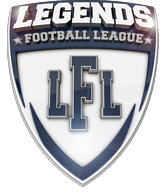LFL Canada
|
Most recent season or competition: 2016 LFL US season |
|
 |
|
| Sport |
American football Women's American football |
|---|---|
| Founded | 2003 |
| Inaugural season | 2009 |
| CEO | Mitch Mortaza |
| Motto | Women of the Gridiron |
| No. of teams | 8 (LFL United States) 4 (LFL Canada) 5 (LFL Australia) |
| Countries |
|
| Most recent champion(s) |
Chicago Bliss (Legends Football League) (3rd title) BC Angels (LFL Canada) (1st title) New South Wales Surge (LFL Australia) (1st title) |
| Most titles | Los Angeles Temptation (5) |
| TV partner(s) | FUSE,www.youtube.com/mylfl |
| Official website | www.LFLUS.com |
The Legends Football League (LFL) is a women's 7-on-7 tackle American football league, with games played in the spring and summer at NBA, NFL, NHL and MLS arenas and stadiums. The league was founded in 2009 as the Lingerie Football League and was rebranded as the Legends Football League in 2013. The league's founder and chairman is Mitchell S. Mortaza, and the league's administrative offices are located in Los Angeles.
The concept of the LFL originated from an alternative Super Bowl halftime television special called the Lingerie Bowl, a pay-per-view event broadcast opposite the Super Bowl halftime show. The first three Lingerie Bowls were held annually from 2004 to 2006 and were billed as Lingerie Bowls I, II, and III. From 2007 to 2009, the next three planned Lingerie Bowls (billed as Lingerie Bowls IV, V, and VI) were all cancelled for various reasons. In 2009, LFL chairman Mitch Mortaza expanded the concept from a single annual exhibition game to a ten-team lingerie football league.
Most LFL teams in the United States use the same color scheme as a professional men's football team in the area. Generally, this would be the local NFL teams, although UFL (Las Vegas, Orlando), and former NFL (Los Angeles) teams' color schemes have been used in areas with no current NFL team. In Canada, the teams' colors are based on either CFL teams (Toronto, Regina) or ice hockey teams (BC, Saskatoon). As of 2014, some teams in Australia use the local state colors. In addition, a small number of US based have adopted their own color schemes not reflective of other local teams.
...
Wikipedia
